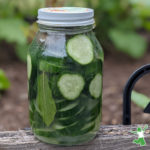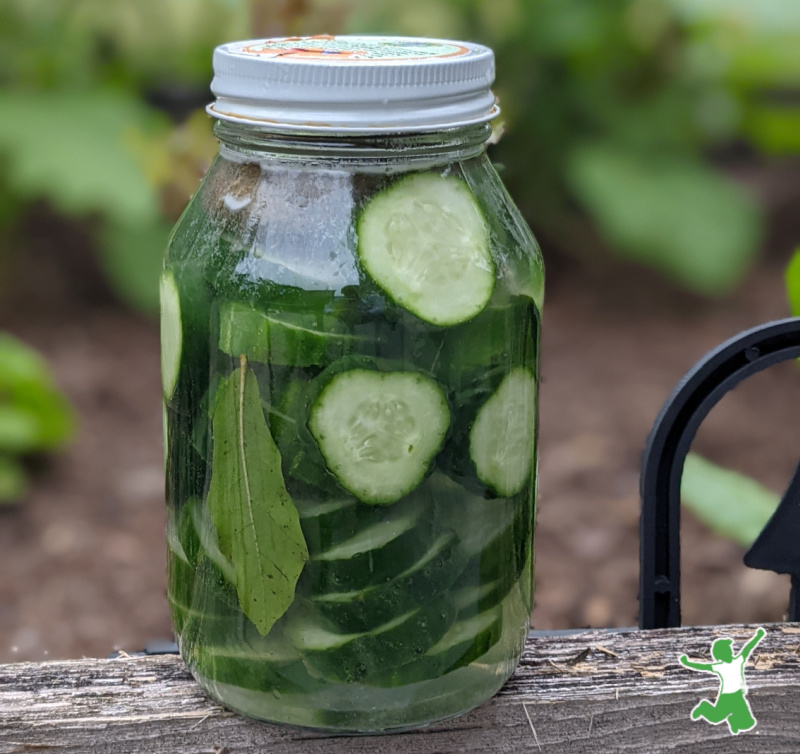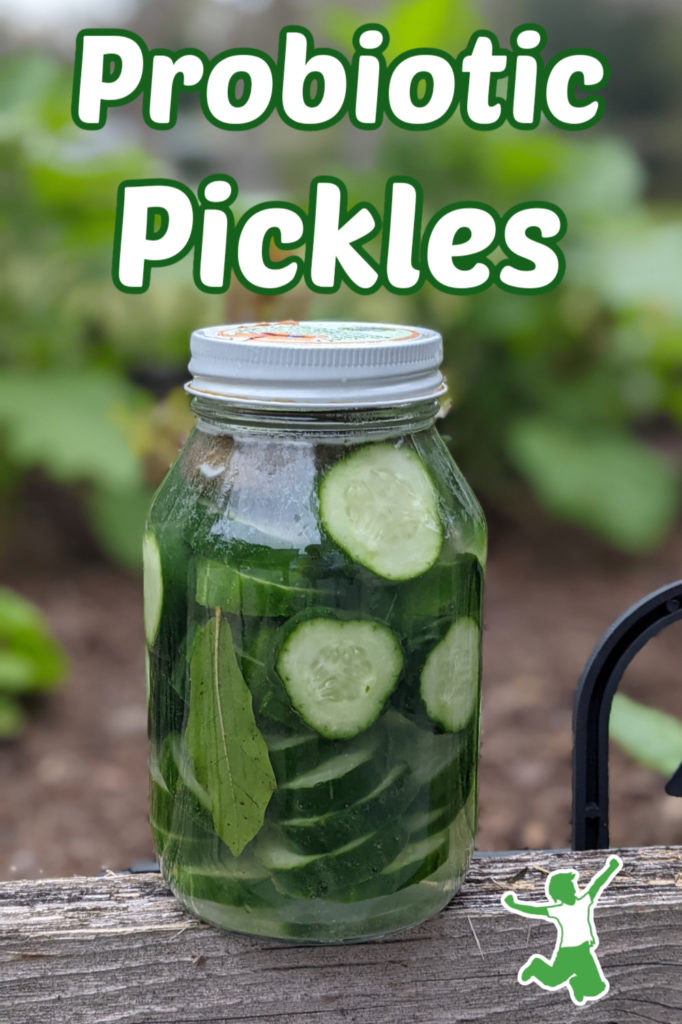Table of Contents[Hide][Show]
How to make healthy probiotic pickles the old fashioned way by fermenting sliced cucumbers in water, sea salt and a culturing medium.
When my Australian husband first moved to the United States some years ago after we first got engaged, he commented that Americans must really love pickles. No matter where you go in the United States, deli sandwiches are almost invariably served with some sort of pickle on the side.
It’s true. Americans do love pickles. Sweet pickles, sour pickles, dill pickles, it doesn’t seem to really matter what type – Americans consider them an essential condiment, and the wide variety of pickles at the supermarket is a strong testament to this fact.
The problem with store pickles is that they are for the most part a nutritionless addition to a meal.
The heat required to can pickles or seal and sterilize them in jars that can sit for months or even years on the supermarket shelf or in your pantry without going bad clinches that deal. In short, they are pickled but not fermented. Fermentation is the process whereby cucumbers are pickled without heat which adds beneficial enzymes, probiotics, and sometimes additional nutrients.
The traditional principles of fermentation can be applied to cucumbers just the same as it can to other foods like beets, apricots, tomatoes, and cabbage all of which have been the subject of previous video lessons demonstrating the health building wonders of fermentation.
Why has it taken me so long to do a video lesson on fermented cucumbers, aka real pickles, you might ask? Given their tremendous popularity as a condiment, you would think pickles would have been one of the very first fermentation videos I would have filmed.
True all around, with one very big problem. I’ve never been very good at fermented cucumbers. They always turned out soggy when I’ve made them in the past and who wants to eat soggy pickles?
But then, my friend Alex Lewin sent me a copy of his book Real Food Fermentation, and at last I learned the secret for keeping my fermented cucumbers nice and crisp as they transform into enzyme and probiotic packed pickles that easily beat any store versions in both taste and nutrition.
How to Make Healthy Probiotic Pickles
I asked Alex if I could film his fermented cucumbers, aka REAL pickes recipe as a video, and he graciously said yes, so at long last, The Healthy Home Economist does pickles!
The recipe below includes this video demonstration. If you are a more visual learner, hopefully this will give you an idea of how to make fermented cucumbers at home very easily!

Fermented Cucumbers Recipe
Recipe to culture sliced cucumbers into probiotic fermented pickles that are crisp, tasty, and healthy.
Ingredients
- 2 lbs cucumbers preferably organic, sliced across into 1/4″ pieces, cut off and discard the blossom end
- 1 quart filtered water
- 1/2 cup sauerkraut juice
- 2 Tbl sea salt
- 3-4 fresh oak leaves
- 3-5 garlic cloves peeled, preferably organic, optional
- 3-5 dried bay leaves preferably organic, optional
Instructions
-
Slice cucumbers and set aside. Be sure to discard the slice with the blossom end as this is where enzymes are located that can contribute to soggy pickles.
-
Place garlic cloves, dried bay leaves, and fresh oak, bay or grape leaves at the bottom of a clean 1/2 gallon mason jar.
-
Place sliced cucumbers on top of seasonings. Mix sea salt, liquid whey or sauerkraut juice with the quart of water (or a water/vinegar mixture if you prefer a more vinegar flavor to your pickles) into the fermentation brine water and carefully pour over the top of the cucumbers.
-
Leave fermented cucumbers on the counter for 2 days. After 2 days, remove one cucumber slice with a clean fork and taste. If it is crunchy and pleasantly sour, then refrigerate. Your pickles are done. If not, leave on the counter for another day, tasting each additional day to determine when the pickles taste pleasantly sour and are yet are still crunchy.
-
If a small bit of of foamy bubbles is on top of the brine water, it’s not a problem. Just remove it and refrigerate. If there is a lot of mold with long tendrils down into the water, the batch has not taken properly. Discard and try again using more starter and/or vinegar with your next batch and/or a fermentation weight as a preventative.
-
Properly cultured cucumbers, aka probiotic pickles, will last several months in the refrigerator.
Recipe Video
Recipe Notes
1 pint filtered water and 1 pint organic apple cider vinegar that has been boiled and cooled may be substituted for the quart of filtered water. This will result in a more commercial taste to the healthy pickles.
1/2 cup liquid whey may be substituted for the raw sauerkraut juice.
Fresh bay or grape leaves may be substituted for the fresh oak leaves.
Source
Real Food Fermentation by Alex Lewin
More Fermentation Recipes
How to Make Fermented Lemonade
How to Make Probiotic Sauerkraut










Thank you so much for your recipe! I always had trouble getting my cucumbers to be crunchy and crisp to the bite instead of soggy and wet. The addition of grape leaves / bay leaves to make them crunchy during the fermentation process is fascinating. I wonder what the reasoning is for that – I’ve heard it somewhere before but never really figured to try it until now. Thank you again for your recipe and I’ll have to give this a try soon! Wish me luck!
I made these and I just opened them tonight to try them. There was a weird smell. Not necessarily horrible, but not pleasant either. I used bay leaves and they were on top instead of on the bottom. Could that be the smell? Also, there were little white bubbles on the top. And one of the cucumbers was above the brine. I’m reading now that you have to keep them submerged. How important is that? Other than that, they taste pretty good and are crunchy. I’m mainly concerned about that smell and the one cucumber that’s been half way above the brine for like a day. I put it in the fridge. Should we eat them?
The little white bubbles aren’t a problem. It is actually yeast, not mold. Here’s an article on when to worry about fermentation mold and when it is safe to eat. https://www.thehealthyhomeeconomist.com/mold-fermented-foods-what-to-do/
Next time, try using fermentation weights to prevent any issues.
Hi, just wondering why you need to boil the cider vinegar? Thanks!
Just finished my first batch, yum! Do you think I can reuse the remaining liquid to do a new batch of pickles?
Hi – I’ve tried these twice now and each time I ended up with fuzz or some kind of mold on the top of the water/top of the pickles. I don’t think I should eat it. Right? What am I doing wrong? Thanks for any advice…
You shouldnt ferment with the lid screwed on co2 has to escape during the fermentation process. And getting slight cloudy mold like on surface can be normal and can be skimmed off with a spoon on a regular basis, also ferment for no less then 4 days keep everytbing submerged also, ir look for mason jars with airlocks built in perfect for fermenting let’s co2 out while preventing oxygen and mold in.
The recipe has 2 Tablespoons of salt. Is there a way to make the pickles with less salt for those concerned about salt intake?
Can I use the leaves from the Concord Grapes in my yard?
Peter J. Montano
we keep ours crisp by adding a little loose organic black tea leaves
I ferment pickles but I use a different method,Hungarian, where my family is from…http://www.timvidraeats.com/2012/07/hungarian-kovaszos-uborka-sour-pickles.html